视频地址:
esp32s3 sense接入百度在线语音识别
目前这是我使用的esp32s3官方硬件👍👍👍(小小的身材有大大的力量)只需要35元加摄像头麦克风79元,后期我会整理相关专栏进行arduino系统学习😘😘😘。有需要可以购买xiao开发板💕💕💕,seeedxiao esp32s3 sense硬件购买地址:https://s.click.taobao.com/lekazrt

1. 前言
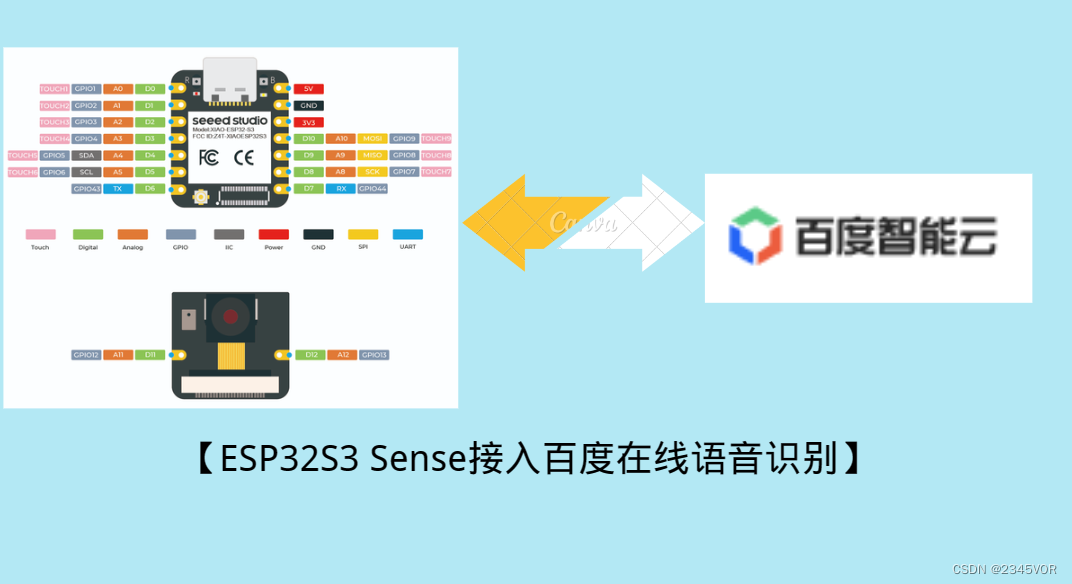
使用seeed xiao esp32s3 sense开发板接入百度智能云实现在线语音识别。自带麦克风模块用做语音输入,通过串口发送字符“1”来控制数据的采集和上传。
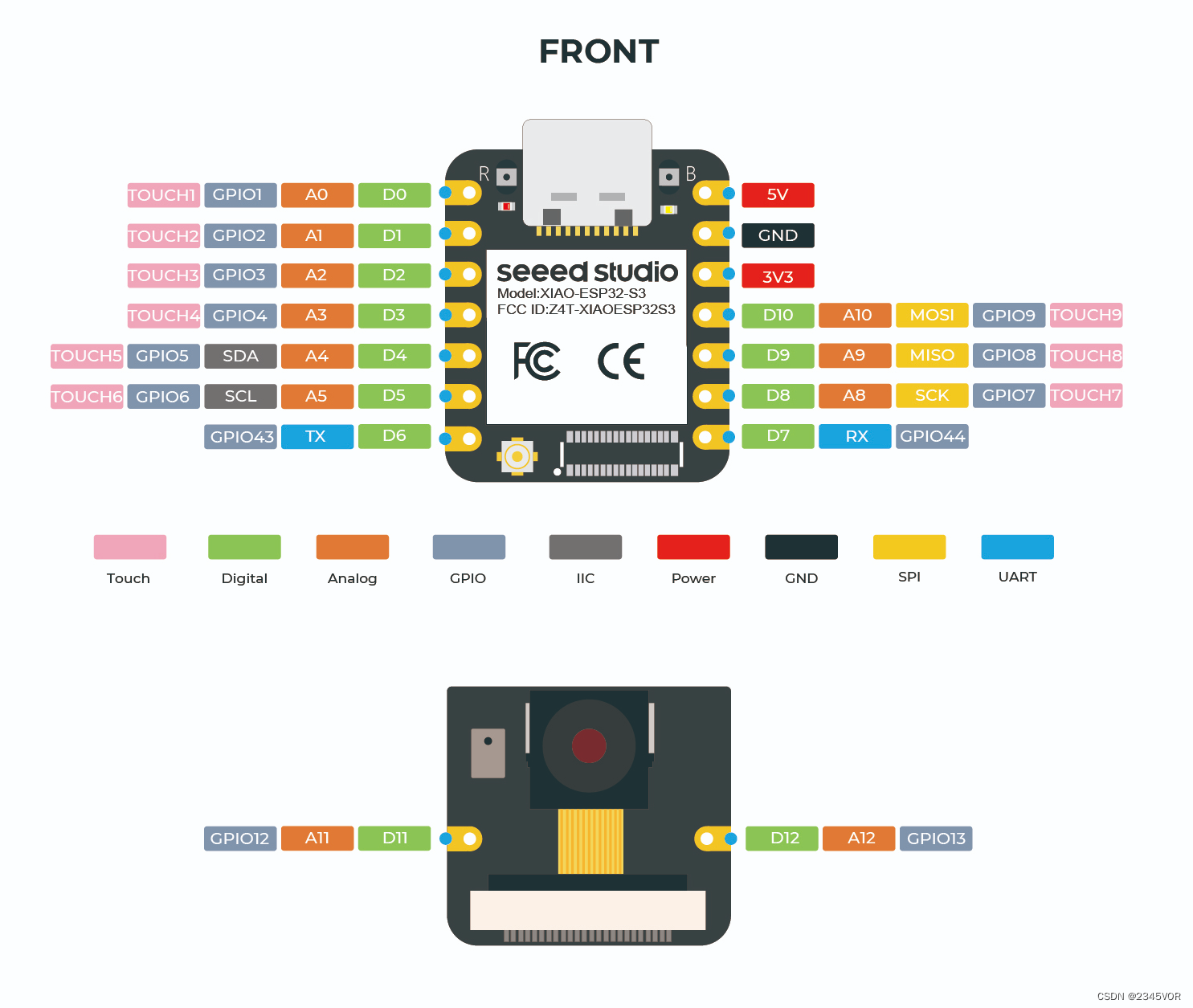
2. 操作流程
2.1 创建语音识别应用
登录百度云账号,选择语音识别
官网地址:https://ai.baidu.com/tech/speech

新用户可以直接领取资源,也可付费接入,创建应用。
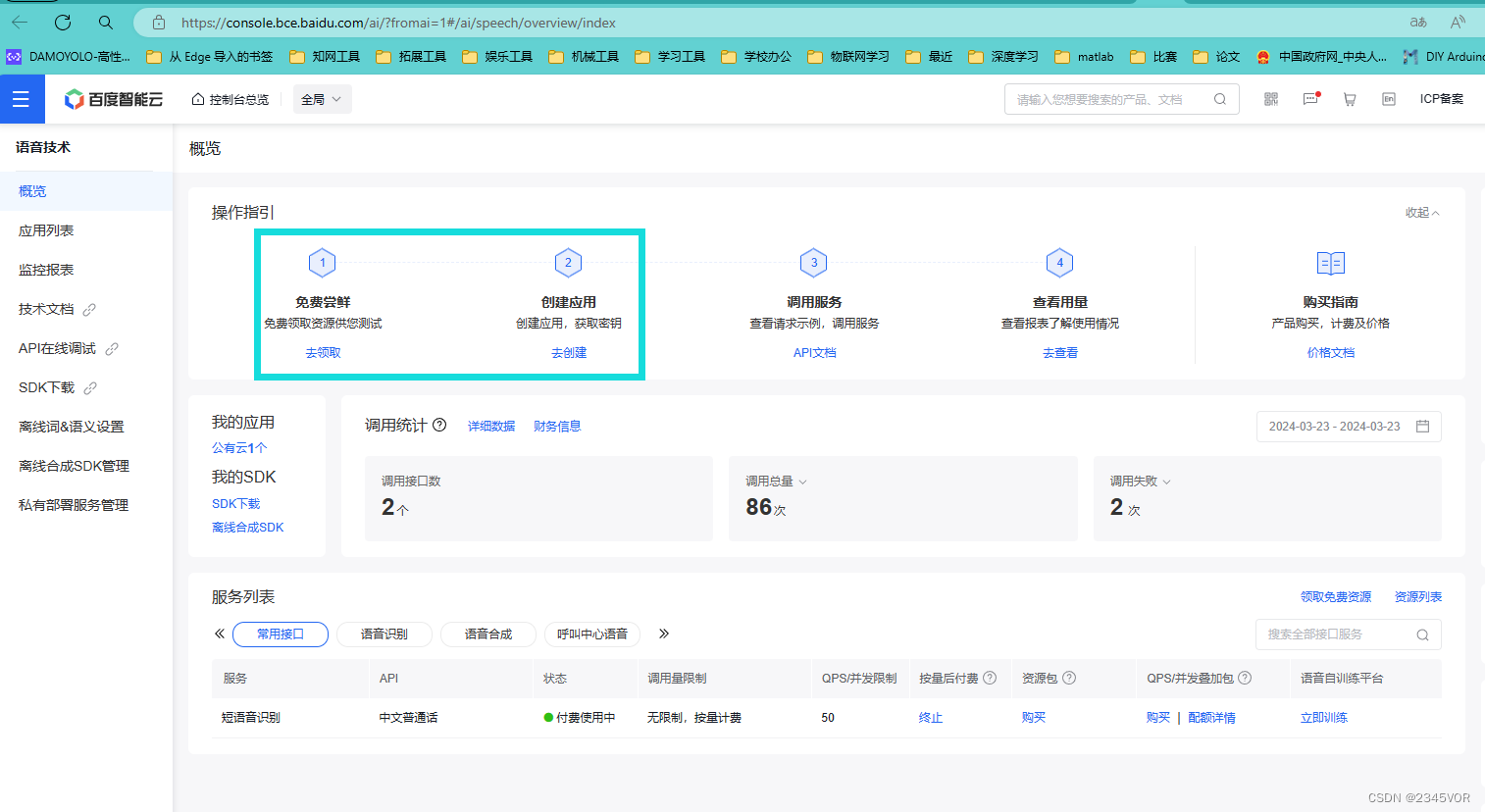
根据创建应用生成的api key和secret key来获取token,创建好应用,点管理应用,会有api key和secret key,如下图应用创建成功
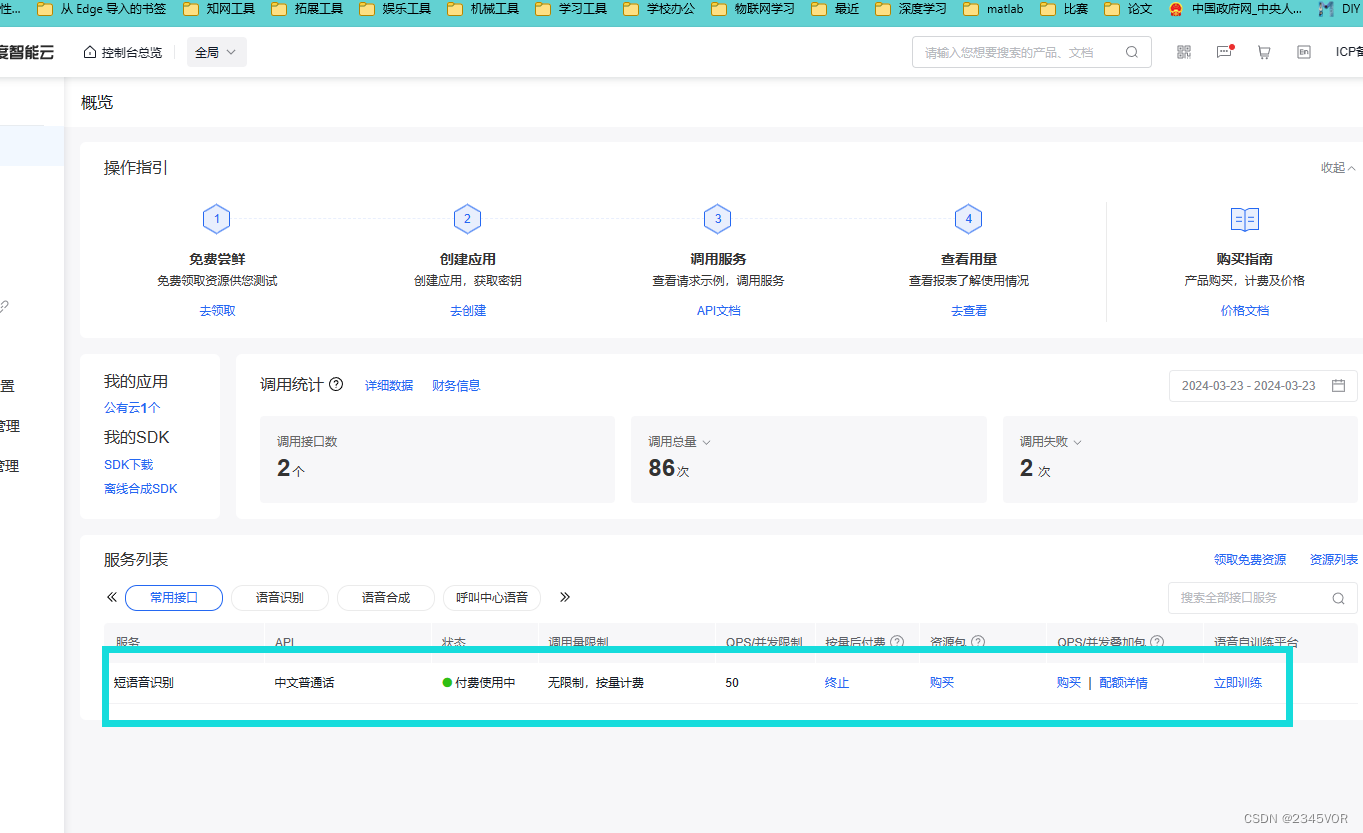
2.2 api秘钥创建
点击在线调试
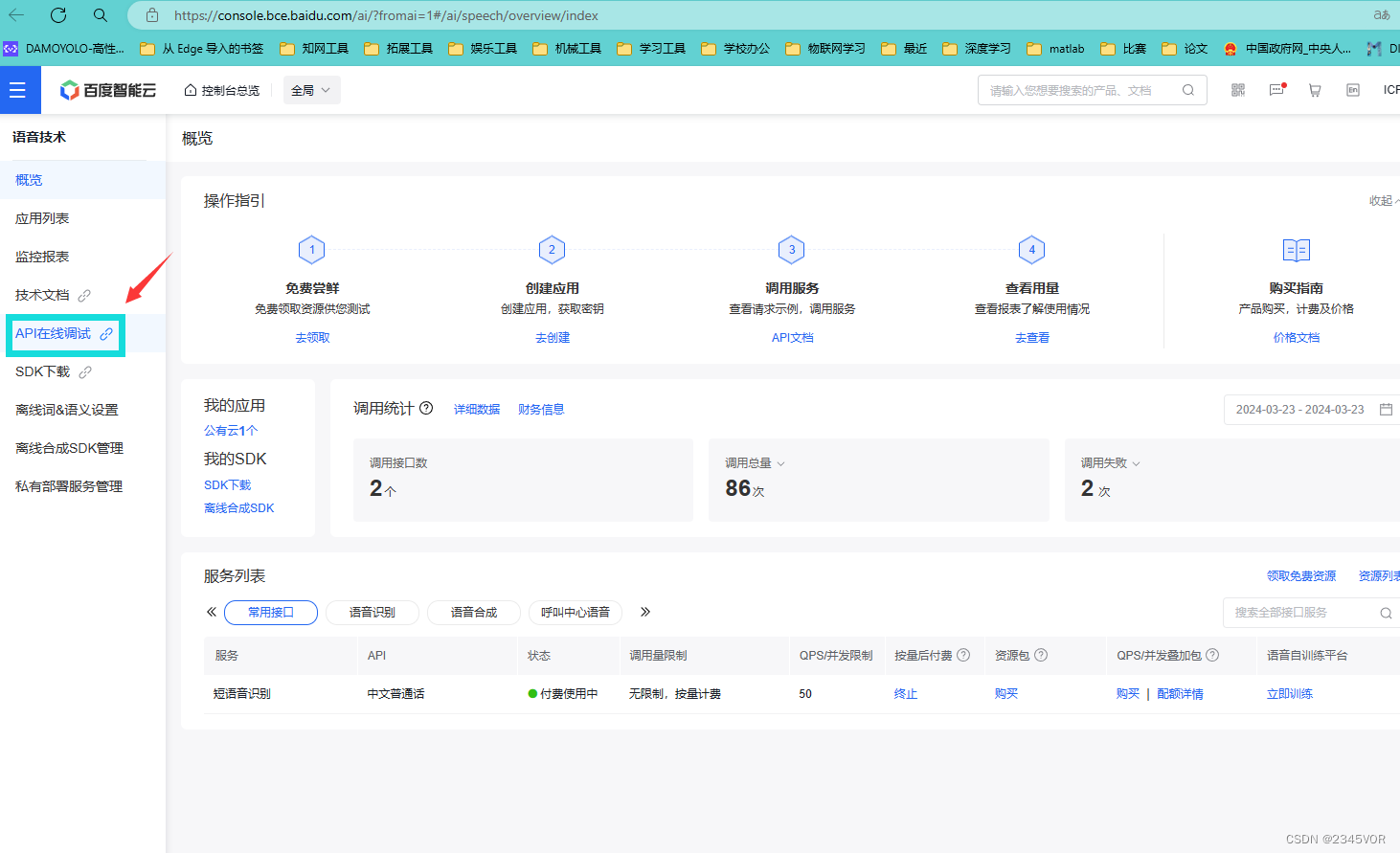
按照如下顺序选择
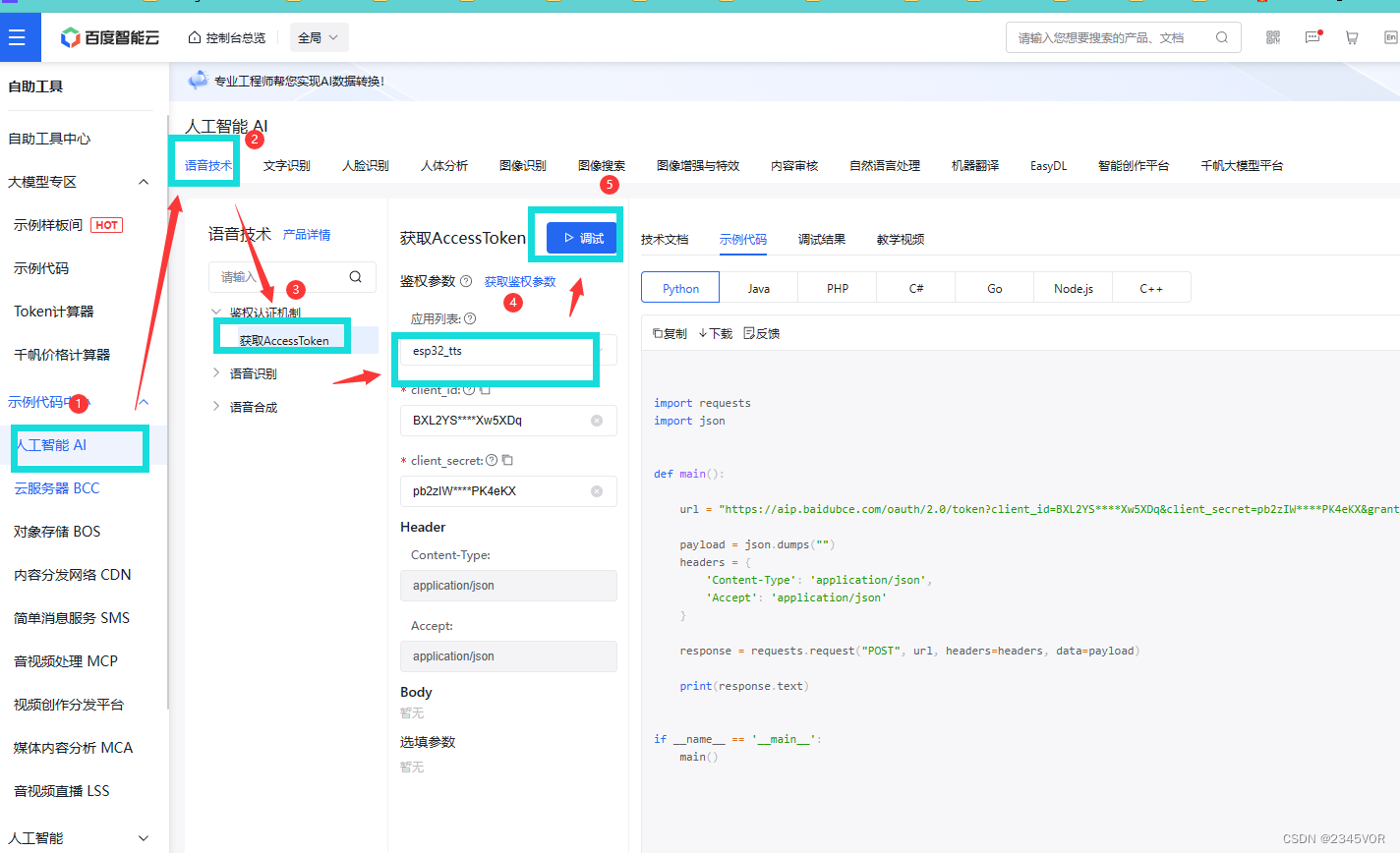
有了api key和secret key就可以得到token,下面附上esp32进行get请求得到token的代码
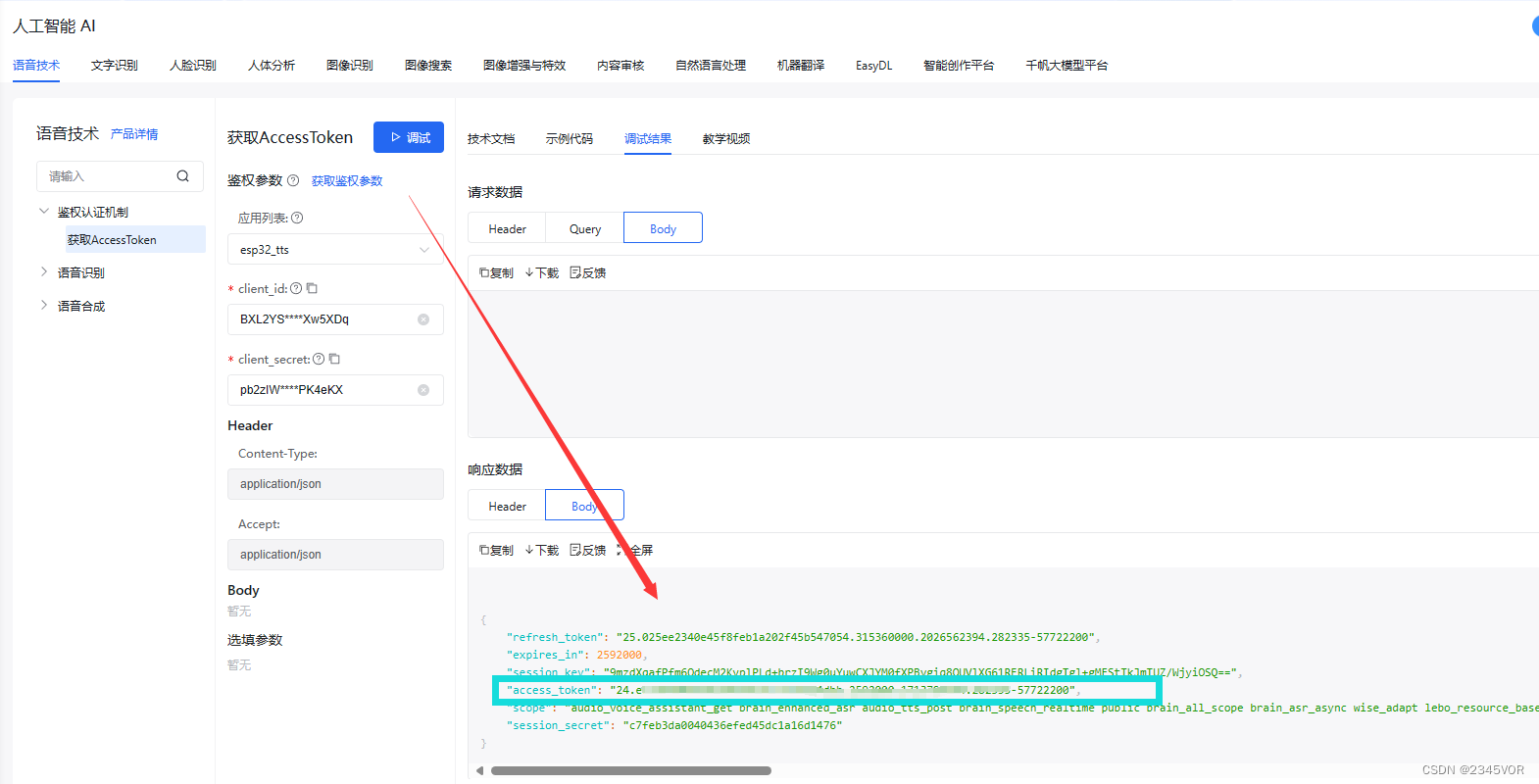
access_token对应的值就是可用的token了,每次申请的token有效期为30天,过期需要重新申请,可以申请多个。不用每次都调用获取token的程序,申请一个可以用30天,定时更新就可以吧。
3. json语音接入
采集数据,post发送到请求api数据上传 post 方式有 2 种:json 格式和raw 格式。
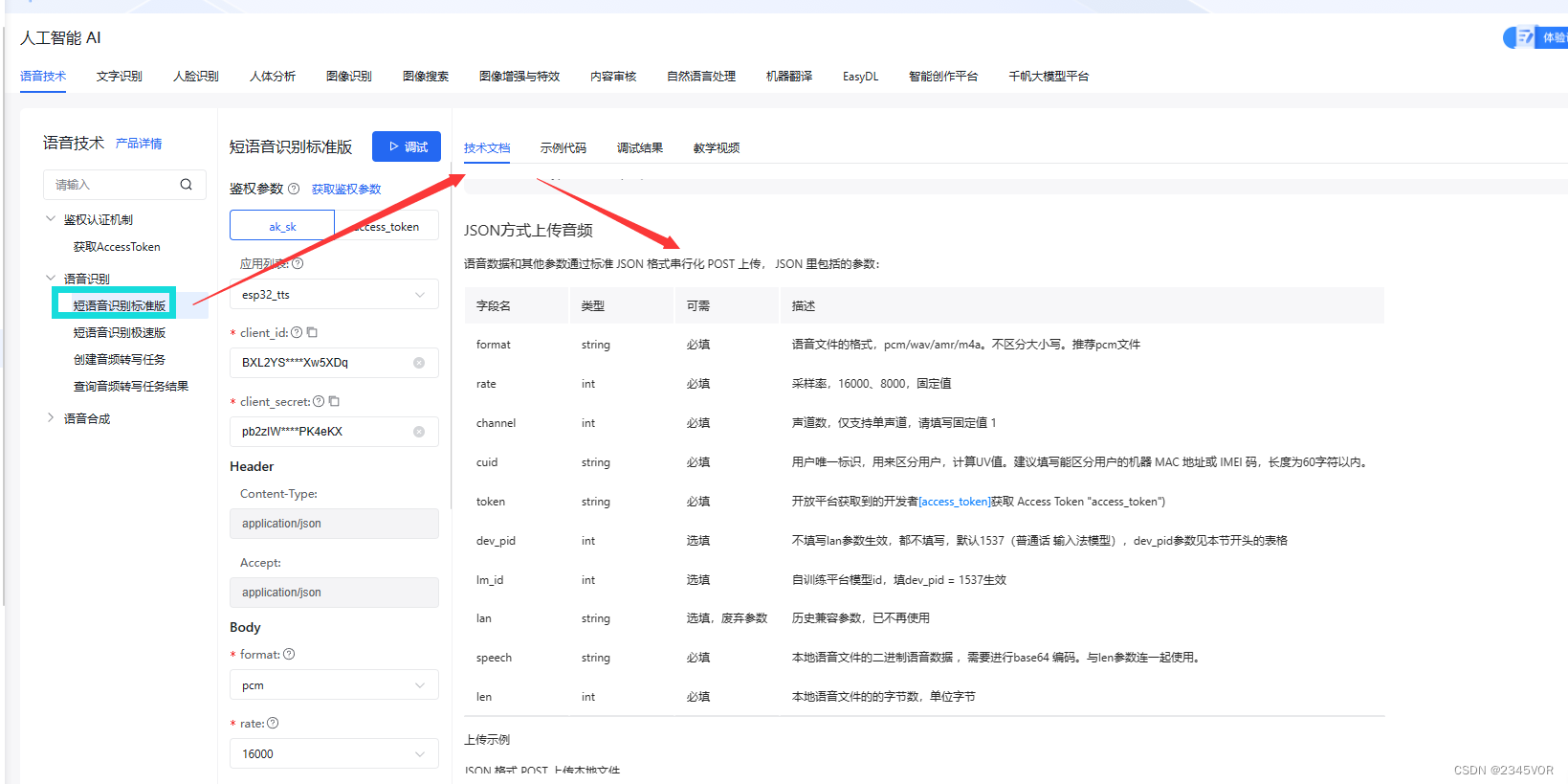
3.1 json格式
这里介绍使用使用json格式上传的方式,下图为json格式上传的一些必要的参数说明
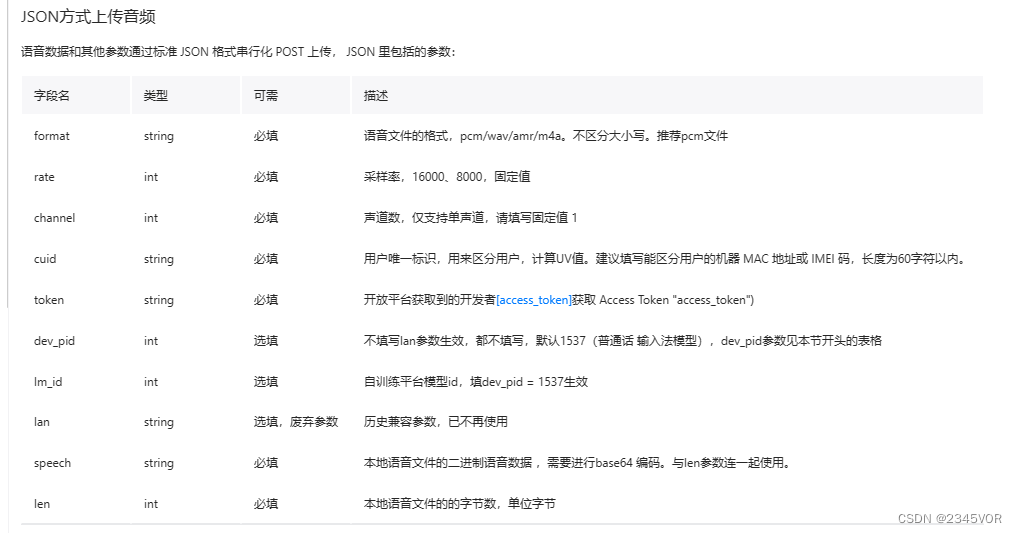
3.2 esp32s3 sense接入代码
图中对数据类型和内容说的很明确了,只需要按照这个格式打包好数据然后发送就行,下面是esp32的具体实现代码。
#include <arduino.h>
#include "base64.h"
#include "wifi.h"
#include "httpclient.h"
#include "cjson.h"
#include <i2s.h>
#include <arduinojson.h>
// #define key 4 //端口0
// #define adc 2 //端口39
// #define led 15 //端口2
const int buttonpin = 1; // the number of the pushbutton pin
const int ledpin = 21; // the number of the led pin
httpclient http_client;
// 1. replace with your network credentials
const char* ssid = "j09 502";
const char* password = "qwertyuiop111";
hw_timer_t* timer = null;
#define data_len 16000
uint16_t adc_data[data_len]; //16000个数据,8k采样率,即2秒,录音时间为2秒,想要实现更长时间的语音识别,就要改这个数组大小
//和下面data_json数组的大小,改大一些。
uint8_t adc_start_flag = 0; //开始标志
uint8_t adc_complete_flag = 0; //完成标志
char data_json[45000]; //用于储存json格式的数据,大一点,json编码后数据字节数变成原来的4/3,所以得计算好,避免出现越界
void iram_attr ontimer();
void gain_token(void);
void setup() {
//serial.begin(921600);
serial.begin(115200);
// pinmode(adc, analog);
// pinmode(buttonpin, input_pullup);
pinmode(ledpin, output);
// start i2s at 16 khz with 16-bits per sample
i2s.setallpins(-1, 42, 41, -1, -1);
if (!i2s.begin(pdm_mono_mode, 16000, 16)) {
serial.println("failed to initialize i2s!");
while (1)
; // do nothing
}
uint8_t count = 0;
wifi.mode(wifi_sta);
wifi.begin(ssid, password);
while (wifi.status() != wl_connected) {
serial.print(".");
count++;
if (count >= 75) {
serial.printf("\r\n-- wifi connect fail! --");
break;
}
vtaskdelay(200);
}
serial.printf("\r\n-- wifi connect success! --\r\n");
// gain_token();
timer = timerbegin(0, 80, true); // 80m的时钟 80分频 1m
timeralarmwrite(timer, 125, true); // 1m 计125个数进中断 8k
timerattachinterrupt(timer, &ontimer, true);
timeralarmenable(timer);
timerstop(timer); //先暂停
}
uint32_t time1, time2;
void loop() {
if (serial.available() > 0) //按键按下
{
if (serial.read() == '1') {
serial.printf("start recognition\r\n\r\n");
digitalwrite(ledpin, high);
adc_start_flag = 1;
timerstart(timer);
// time1=micros();
while (!adc_complete_flag) //等待采集完成
{
ets_delay_us(10);
}
// time2=micros()-time1;
timerstop(timer);
adc_complete_flag = 0; //清标志
digitalwrite(ledpin, low);
// serial.printf("time:%d\r\n",time2); //打印花费时间
memset(data_json, '\0', strlen(data_json)); //将数组清空
strcat(data_json, "{");
strcat(data_json, "\"format\":\"pcm\",");
strcat(data_json, "\"rate\":16000,"); //采样率 如果采样率改变了,记得修改该值,只有16000、8000两个固定采样率
strcat(data_json, "\"dev_pid\":1537,"); //中文普通话
strcat(data_json, "\"channel\":1,"); //单声道
strcat(data_json, "\"cuid\":\"666666\","); //识别码 随便打几个字符,但最好唯一
strcat(data_json, "\"token\":\"24.8f6133335e191.2592000.1713789066.282335-57722200\","); //token 这里需要修改成自己申请到的token
strcat(data_json, "\"len\":32000,"); //数据长度 如果传输的数据长度改变了,记得修改该值,该值是adc采集的数据字节数,不是base64编码后的长度
strcat(data_json, "\"speech\":\"");
strcat(data_json, base64::encode((uint8_t*)adc_data, sizeof(adc_data)).c_str()); //base64编码数据
strcat(data_json, "\"");
strcat(data_json, "}");
// serial.println(data_json);
int httpcode;
http_client.settimeout(5000);
http_client.begin("http://vop.baidu.com/server_api"); //https://vop.baidu.com/pro_api
http_client.addheader("content-type", "application/json");
httpcode = http_client.post(data_json);
if (httpcode == 200) {
if (httpcode == http_code_ok) {
string response = http_client.getstring();
http_client.end();
serial.println(response);
// parse json response
dynamicjsondocument jsondoc(512);
deserializejson(jsondoc, response);
string outputtext = jsondoc["result"][0];
// 访问"result"数组,并获取其第一个元
// 输出结果
serial.println(outputtext);
} else {
serial.printf("[http] get... failed, error: %s\n", http_client.errortostring(httpcode).c_str());
}
}
// while (!digitalread(buttonpin))
// ;
serial.printf("recognition complete\r\n");
}
}
vtaskdelay(1);
}
uint32_t num = 0;
portmux_type timermux = portmux_initializer_unlocked;
void iram_attr ontimer() {
// increment the counter and set the time of isr
portenter_critical_isr(&timermux);
if (adc_start_flag == 1) {
//serial.println("");
// adc_data[num] = analogread(adc);
adc_data[num] = i2s.read();
num++;
if (num >= data_len) {
adc_complete_flag = 1;
adc_start_flag = 0;
num = 0;
//serial.println(complete_flag);
}
}
portexit_critical_isr(&timermux);
}
// void gain_token(void) //获取token
// {
// int httpcode;
// //注意,要把下面网址中的your_apikey和your_secretkey替换成自己的api key和secret key
// http_client.begin("https://aip.baidubce.com/oauth/2.0/token?grant_type=client_credentials&client_id=your_apikey&client_secret=your_secretkey");
// httpcode = http_client.get();
// if (httpcode > 0) {
// if (httpcode == http_code_ok) {
// string payload = http_client.getstring();
// serial.println(payload);
// }
// } else {
// serial.printf("[http] get... failed, error: %s\n", http_client.errortostring(httpcode).c_str());
// }
// http_client.end();
// }
3.3 esp32接入代码
使用esp32接入百度智能云实现在线语音识别,max9814麦克风模块接gpio2用做语音输入,一个按键接gpio3来控制数据的采集和上传
#include <arduino.h>
#include "base64.h"
#include "wifi.h"
#include "httpclient.h"
#include "cjson.h"
#include <arduinojson.h>
// 1、修改按键和max9814接口
#define key 3
#define adc 2
// 2、修改百度语言技术的用户信息:https://console.bce.baidu.com/ai/?fromai=1#/ai/speech/app/list
const int dev_pid = 1537;
const char *cuid = "577200";
const char *client_id = "bxl2ys33b7xw5xdq";
const char *client_secret = "pb2ziw2nch2untc9wpk4ekx";
string token;
// 全局变量声明
httpclient http_client;
hw_timer_t *timer = null;
const int recordtimeseconds = 3;//录音时间秒为单位
const int adc_data_len = 16000 * recordtimeseconds;
const int data_json_len = adc_data_len * 2 * 1.4;
uint16_t *adc_data;
char *data_json;
uint8_t adc_start_flag = 0;
uint8_t adc_complete_flag = 0;
uint32_t num = 0;
portmux_type timermux = portmux_initializer_unlocked;
// 函数声明
void iram_attr ontimer();
string gaintoken();
void assemblejson(string token);
void sendtostt();
void setup() {
serial.begin(115200);
pinmode(adc, analog);
pinmode(key, input_pullup);
wifi.disconnect(true);
// 3、填写您的wifi账号密码
wifi.begin("j09 502", "qwertyuiop111");
while (wifi.status() != wl_connected) {
serial.print(".");
vtaskdelay(200);
}
serial.println("\n-- wifi connect success! --");
token = gaintoken();
timer = timerbegin(0, 40, true);
timeralarmwrite(timer, 125, true);
timerattachinterrupt(timer, &ontimer, true);
timeralarmenable(timer);
timerstop(timer); // 先暂停
// 动态分配psram
adc_data = (uint16_t *)ps_malloc(adc_data_len * sizeof(uint16_t));
if (!adc_data) {
serial.println("failed to allocate memory for adc_data");
}
data_json = (char *)ps_malloc(data_json_len * sizeof(char)); // 根据需要调整大小
if (!data_json) {
serial.println("failed to allocate memory for data_json");
}
}
uint32_t time1, time2;
void loop() {
if (digitalread(key) == 1) {
delay(10);
if (digitalread(key) == 1) {
serial.println("开始录音");
adc_start_flag = 1;
timerstart(timer);
while (!adc_complete_flag) {
ets_delay_us(10);
}
serial.println("录音结束");
timerstop(timer);
adc_complete_flag = 0;
assemblejson(token);
sendtostt();
// while (!digitalread(key));
serial.println("recognition complete");
}
}
}
void assemblejson(string token) {
memset(data_json, '\0', data_json_len * sizeof(char));
strcat(data_json, "{");
strcat(data_json, "\"format\":\"pcm\",");
strcat(data_json, "\"rate\":16000,");
strcat(data_json, "\"dev_pid\":1537,");
strcat(data_json, "\"channel\":1,");
strcat(data_json, "\"cuid\":\"57722200\",");
strcat(data_json, "\"token\":\"");
strcat(data_json, token.c_str());
strcat(data_json, "\",");
sprintf(data_json + strlen(data_json), "\"len\":%d,", adc_data_len * 2);
strcat(data_json, "\"speech\":\"");
strcat(data_json, base64::encode((uint8_t *)adc_data, adc_data_len * sizeof(uint16_t)).c_str());
strcat(data_json, "\"");
strcat(data_json, "}");
}
void sendtostt() {
http_client.begin("http://vop.baidu.com/server_api");
http_client.addheader("content-type", "application/json");
int httpcode = http_client.post(data_json);
if (httpcode > 0) {
if (httpcode == http_code_ok) {
string payload = http_client.getstring();
serial.println(payload);
}
} else {
serial.printf("[http] post failed, error: %s\n", http_client.errortostring(httpcode).c_str());
}
http_client.end();
}
void iram_attr ontimer() {
// increment the counter and set the time of isr
portenter_critical_isr(&timermux);
if (adc_start_flag == 1) {
// serial.println("");
adc_data[num] = analogread(adc);
num++;
if (num >= adc_data_len) {
adc_complete_flag = 1;
adc_start_flag = 0;
num = 0;
// serial.println(complete_flag);
}
}
portexit_critical_isr(&timermux);
}
string gaintoken() {
httpclient http;
string token;
string url = string("https://aip.baidubce.com/oauth/2.0/token?grant_type=client_credentials&client_id=") + client_id + "&client_secret=" + client_secret;
http.begin(url);
int httpcode = http.get();
if (httpcode > 0) {
string payload = http.getstring();
dynamicjsondocument doc(1024);
deserializejson(doc, payload);
token = doc["access_token"].as<string>();
serial.println(token);
} else {
serial.println("error on http request for token");
}
http.end();
return token;
}
上面代码是将数据拼接成要求的json的格式并通过post的方式发送到请求api,并接收打印返回的数据消息。使用的定时器设置成8k频率定时采集音频数据,上面代码中并未展示,后面会附上完整代码。
esp32是有json库的,在 “cjson.h” 头文件中,但是我没有用,因为我发现数据太长时不知道为啥会出现莫名其妙的错误,也没深究,就使用函数strcat()将数据拼接成规定的格式,好使,就是写的时候麻烦一些,但问题不大。
post发送数据有一个固定头部:content-type:application/json,post前需要设置一下。
4. 接收数据
参考以下烧录配置,
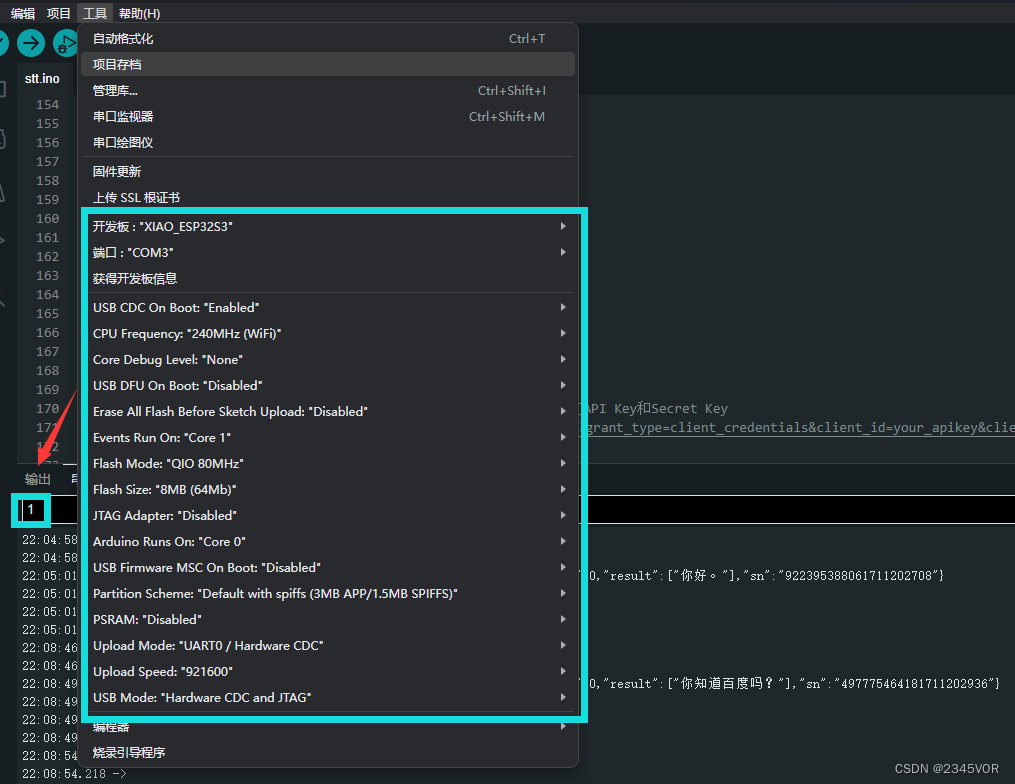
串口输入字符“1”,点击按回车键,然后有2s录音时间。等待百度在线语音识别返回,在上一步的代码中实现了接收数据,这里列一下返回的数据。
22:04:58.854 -> start recognition
22:04:58.854 ->
22:05:01.558 -> {"corpus_no":"7349559668823131804","err_msg":"success.","err_no":0,"result":["你好。"],"sn":"922395388061711202708"}
22:05:01.558 ->
22:05:01.558 -> 你好。
22:05:01.558 -> recognition complete
22:08:46.838 -> start recognition
22:08:46.838 ->
22:08:49.809 -> {"corpus_no":"7349560648200206506","err_msg":"success.","err_no":0,"result":["你知道百度吗?"],"sn":"497775464181711202936"}
22:08:49.809 ->
22:08:49.809 -> 你知道百度吗?
22:08:49.809 -> recognition complete
22:08:54.218 -> start recognition
22:08:54.218 ->
22:08:57.084 -> {"corpus_no":"7349560678205790969","err_msg":"success.","err_no":0,"result":["我喜欢小黄人。"],"sn":"748488478211711202943"}
22:08:57.084 ->
22:08:57.084 -> 我喜欢小黄人。
22:08:57.084 -> recognition complete
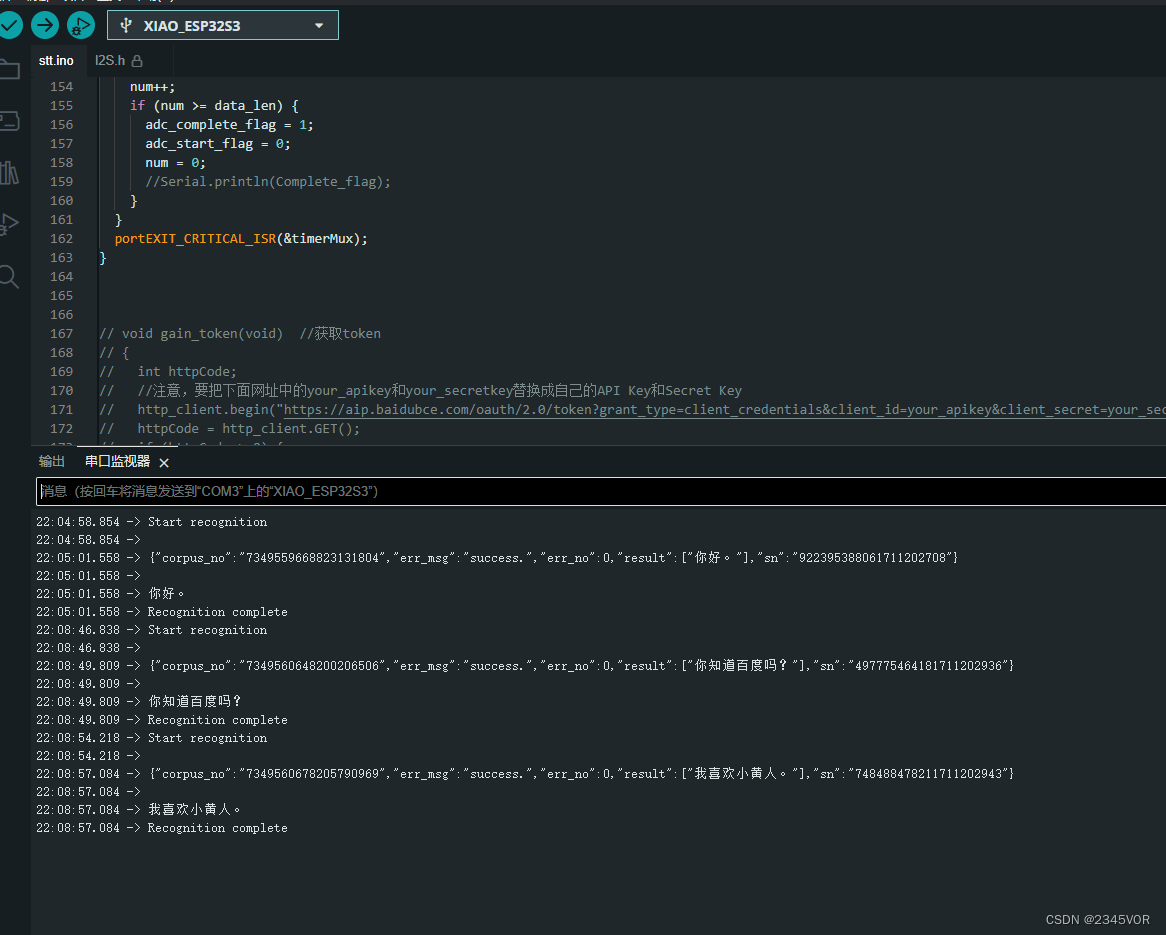
数据发送成功则会返回正确的识别数据,当然声音信号不好时返回的语音识别也会不准确。
5. 总结
本文使用seeed xiao esp32s3 sense开发板接入百度智能云实现在线语音识别。自带麦克风模块用做语音输入,通过串口发送字符“1”来控制数据的采集和上传。从而实现对外部世界进行感知,充分认识这个有机与无机的环境,科学地合理地进行创作和发挥效益,然后为人类社会发展贡献一点微薄之力。🤣🤣🤣





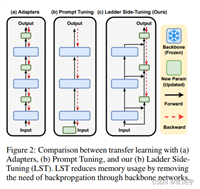
发表评论